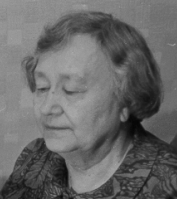Some Important Contributions:
Fundamental work in the theory of flow through porous materials.
Developed a general method of solving two-dimensional problems for seepage in homogeneous topsoils.
"Kochina's research activity is characterized by a deep and well-organized link with practice, a subtle attention to the physical essence of
the phenomena being considered, an exact mathematical formulation of the relevant physical problems, and by a brilliant mastery of the
mathematical apparatus." --- P.S. Aleksandrov [1FF N20]
Some Important Publications:
Theory of Groundwater Movement, Translated by J.M. DeWiest, Princeton University Press (1962) [completed in 1952]
"On an Integral Flow Equation for Tanks of Constant Depth," Izvestiya Akademii Nauk, 2:249-270 (1938)
"Application of the Theory of Linear Differential Equations to Some Cases of Motion of Groundwater:I," Izvestiya Akademii Nauk 2:371-398 (1938)
"Application of the Theory of Linear Differential Equations to Some Cases of Motion of Groundwater:II," Izvestiya Akademii Nauk 3:329-350 (1939)
"Application of the Theory of Linear Differential Equations to Some Cases of Motion of Groundwater:III," Izvestiya Akademii Nauk 3:579-602 (1939)
Honors:
Stalin Prize 1946
Corresponding Member, USSR Academy of Sciences 1946
Academician, USSR Academy of Sciences 1958 [this is the Academy's highest rank]
Hero of Socialist Labor 1969
Order of the Friendship of Nations 1979 [1FF N20]
Jobs/Positions:
1919-21 Staff, Main Physical (later Geophysical) Observatory, Petrograd
1921-27 Staff, Institute of Transportation
1927-34 Assistant Lecturer, Leningrad University
1931-34 Staff, Institute of Civil Aviation Engineering, Leningrad
1934-35 Professor, Leningrad University
1935-?? Senior Research Associate, Division of Mechanics, Steklov Mathematics Institute, Moscow (In 1939, this division
became the Institute of Mechanics of the Academy of Sciences)
1948-59 Director, Division of Hydromechanics, Institute of Mechanics, University of Moscow
1953-57 Associate, Mathematics Institute, (later Mechanic
Institute), USSR Academy of Science
1959-70 Director, Praesidium, Siberian Branch, Academy of
Sciences, Novosibirsk
1959 -70 Director, Department of Applied Hydrodynamics, Hydrodynamics Institute, Novosibirsk
1959-70 Head, Department of Theoretical Mechanics, University of Novosibirsk
1970- Director, Section for Mathematical Methods of Mechanics, Institute for Problems in Mechanics, Moscow [28D WOM]
Education:
Degree in Pure Mathematics, Petrograd University 1921
Doctor of Physical and Mathematical Sciences 1940
[28D WOM],
[29 WWWS],
[50 JT],
[62 IT],
[as1989rc],
[Kochina's Memoirs, Nauka, gody Iyndi(in Russian)] ,
[1FF N20]
Additional Information/Comments: The
Russian Revolution of 1917 ended the system of gender discrimination
against women that had existed in Tsarist Russia. Kochina benefited from
this change as her courses at the Bestudzevskii women's program were then incorporated into the University of Petrograd.
Kochina is married to Nikolai Evgrafovich Kochin and they have two daughters.
Kochina's husband was the head of the division of mechanics in the Steklov Mathematics Institute
in Moscow. In Moscow, Kochina became a senior research associate in Kochin'
division. The two were members of the "Stalinist" scientific elite; both supported the Communist state. Kochin served in
combat divisions in the Red Army. Kochina served as a deputy to the Leningrad (city) Soviet in the late 1920s and early 1930s, as a
deputy in the Moscow (city) Soviet after 1935 and as a deputy in the Supreme Soviet of the Russian Republic. These posts indicate
Kochina's high standing within the Communist party structure. As George W. Phillips has written, "the selection is limited to
high-ranking Party members and to non-Party individuals of oustanding achievement." Kochina was also chosen to represent the Soviet
Union at a number of international political and scientific conferences.
[28D WOM]
Kochina remained in Moscow until 1959 when she volunteered to move to Siberia to establish the Siberian branch of the Academy of
Sciences at Novosibirsk. She served on the Academy's ruling board, the Praesidium, for years and then as its director from 1959 to
1970. [28D WOM]
Kochina was a pioneer of the history of Russian mathematics. She was the first person to write extensively about the great 19th
century mathematician Sofia Kovalevskaia, and also helped publish several volumes of her husband's work. A few of Kochina's many
publications on the history of mathematics includes:
S. V. Kovalevskaya, Scientific Works, USSR Academy of Sciences,
1948
The collected mathematical works, with commentary, of the mathemetician Sonya Kovalevskaya
Kochina actively participated in women's movements for peace.
[1FF N20]
Field Editor: Professor Roger Cooke
<cooke@emba.uvm.edu>
|
 Welcome
to CWP at UCLA
Welcome
to CWP at UCLA  Welcome
to CWP at UCLA
Welcome
to CWP at UCLA 